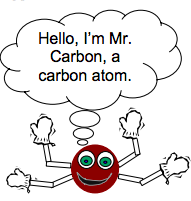Carbon Cycle Resources - Leitzel Center at the University of New Hampshire
GLOBE Carbon Cycle Resources

These resources compliment GLOBE Carbon Cycle Protocols, Learning Activities, Modeling Activities, and Classroom Experiments. Learn more about the GLOBE Carbon Cycle materials here.
Videos
NASA eClips Real World: The Carbon Cycle - Essential for Life on Earth. Learning how carbon is converted through slow- and fast-moving cycles helps us understand how this life-sustaining element moves through the environment. Discover how NASA measures carbon through both field work and satellite imager. Features the GLOBE program!
Trees Around the GLOBE Webinar with Dr. Erika Podest, a research scientist with the Carbon Cycle and Ecosystems Group at the NASA Jet Propulsion Laboratory in California USA, titled "Trees: the Lungs of the Earth; Carbon Cycle Science".
Websites
Carbon Cycle Virtual Field Trip. In this immersive virtual experience, learners explore the processes of the Carbon Cycle. Through tying photosynthesis, cellular respiration, decomposition, sedimentation, combustion, and exchange to physical place, learners see how carbon moves between land, water, air, and living things in Earth’s systems. This project is funded by the Stanford Accelerator for Learning and by the Gordon and Betty Moore Foundation Grant GBMF10266 to support the work of the Virtual Field Trips.
All the Biomass on Earth - This very cool graphic from Nautilus Magazine shows all the biomass on Earth broken down by animal group and then compares to biomass in other forms of life.
Interactive continental US map of estimated biomass. Click on the 'Biomass' Data Layer. For more information on this data set, see the LandTrendr Biomass page and this article. Citation: Hooper, S., & Kennedy, R. E. (2018). A spatial ensemble approach for broad-area mapping of land surface properties. Remote Sensing of Environment, 210, 473-489.
Peer Reviewed Articles
Finzi, AC et al. 2020. Carbon budget of the Harvard Forest Long‐Term Ecological Research site: pattern, process, and response to global change. Ecological Monographs.
Kosiba. 2023. Introduction to Forest Carbon. Northern Woodlands, 44-49.
Kosiba. 2023. Understanding Forest Carbon. Northern Woodlands, 33-39.
Complimentary Activities
Carbon Travels Game Online Version - The same Carbon Travels Game you know and love, but in a Google Doc, so students can play online. Links connect pools and fluxes and bring you to the right place! (Pre and Post 1700s versions are linked, if needed, here are the separate links to the Pre-1700s game, and Post-1700s game).
Carbon Cycle Activities Slideshow from the GLOBE European Phenology Campaign - examples of students activities and projects around carbon. The activities can be found on the European Phenology Campaign Webpage under 'Activities for Students'.
My NASA Data Biosphere Mini Lessons. Includes: Systems and System Models: Atmospheric Carbon Dioxide Model, Cause and Effect: The Secret Life of Forests, Carbon Dioxide: Production and Sequestration, and many more!
Blue Carbon: Bringing Field Research and ArcGIS Mapping to the High School Classroom - High School unit on carbon cycle and urban heat island phenomena.
Natural Inquirer Issues
The Natural Inquirer is a USDA Forest Service publication that offers science journals and readers for preK-12 students. Below are carbon-related issues geared towards middle and high school students
- Balancing Act: Urban Trees and the Carbon Cycle.
- FACElook: Exploring the relationships between carbon, photosynthesis, and the roots of trees.
- Where in the World is Carbon Dioxide?
- Urban Forests
GLOBE Carbon Protocol FAQ with Dr. Scott Ollinger, PI on the Carbon Cycle Project, UNH
Q: Carbon calculations are based only on the diameter of the three, why is the height of the tree not interesting? What is the point of using GLOBE Observer app for trees if only the diameter is interesting?
Dr. Ollinger: Some allometric equations do indeed use height as well as diameter. It’s generally an improvement, but less common given the effort involved and difficulty in closed-canopy forests. We opted for diameter only, because it’s easier to implement for most teachers and because the objectives didn’t require high levels of precision.
Q: In some places I see biomass in kg, and in others I see g/m2. Why?
Dr. Ollinger: The biomass of a single tree is expressed as a unit of mass (e.g. kg) rather than mass per unit area (g/m2). But when expressing biomass over a whole plot or some area containing multiple trees, units are mass per unit area.
Q: Is this Jenkins diagram something that works also for Finnish trees? Our climate is much more severe and trees are here rather small. (See Jenkins et al. figure here, pg. 19)
Dr. Ollinger: The Jenkins et al. equations were developed using studies conducted across North America, including boreal forest species like Picea mariana. Having said that, using locally derived equations is always good when they’re available. A comparison of the two approaches would be a great project for a class in Finland.
Carbon Cycle Q&A from the 2021 GLOBE Annual Meeting.
Many of your carbon cycle questions answered in this Google Doc. We will continue adding to this page as more questions come to us!





